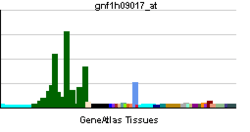CPNE4
| CPNE4 | ||||||
|---|---|---|---|---|---|---|
| Identifiers | ||||||
| Aliases | CPNE4, COPN4, CPN4, copine 4 | |||||
| External IDs | MGI: 1921270 HomoloGene: 26078 GeneCards: CPNE4 | |||||
| Genetically Related Diseases | ||||||
| amyotrophic lateral sclerosis[1] | ||||||
| RNA expression pattern | ||||||
 | ||||||
| More reference expression data | ||||||
| Orthologs | ||||||
| Species | Human | Mouse | ||||
| Entrez | ||||||
| Ensembl | ||||||
| UniProt | ||||||
| RefSeq (mRNA) | ||||||
| RefSeq (protein) |
| |||||
| Location (UCSC) | Chr 3: 131.53 – 132.29 Mb | Chr 9: 104.55 – 105.03 Mb | ||||
| PubMed search | [2] | [3] | ||||
| Wikidata | ||||||
| View/Edit Human | View/Edit Mouse |
Copine-4 is a protein that in humans is encoded by the CPNE4 gene.[4][5][6]
Calcium-dependent membrane-binding proteins may regulate molecular events at the interface of the cell membrane and cytoplasm. This gene is one of several genes that encode a calcium-dependent protein containing two N-terminal type II C2 domains and an integrin A domain-like sequence in the C-terminus.[6]
References
- ↑ "Diseases that are genetically associated with CPNE4 view/edit references on wikidata".
- ↑ "Human PubMed Reference:".
- ↑ "Mouse PubMed Reference:".
- ↑ Creutz CE, Tomsig JL, Snyder SL, Gautier MC, Skouri F, Beisson J, Cohen J (Feb 1998). "The copines, a novel class of C2 domain-containing, calcium-dependent, phospholipid-binding proteins conserved from Paramecium to humans". J Biol Chem. 273 (3): 1393–402. doi:10.1074/jbc.273.3.1393. PMID 9430674.
- ↑ Maitra R, Grigoryev DN, Bera TK, Pastan IH, Lee B (Apr 2003). "Cloning, molecular characterization, and expression analysis of Copine 8". Biochem Biophys Res Commun. 303 (3): 842–7. doi:10.1016/S0006-291X(03)00445-5. PMID 12670487.
- 1 2 "Entrez Gene: CPNE4 copine IV".
Further reading
- Rual JF, Venkatesan K, Hao T, et al. (2005). "Towards a proteome-scale map of the human protein-protein interaction network.". Nature. 437 (7062): 1173–8. doi:10.1038/nature04209. PMID 16189514.
- Gerhard DS, Wagner L, Feingold EA, et al. (2004). "The status, quality, and expansion of the NIH full-length cDNA project: the Mammalian Gene Collection (MGC).". Genome Res. 14 (10B): 2121–7. doi:10.1101/gr.2596504. PMC 528928
 . PMID 15489334.
. PMID 15489334. - Ota T, Suzuki Y, Nishikawa T, et al. (2004). "Complete sequencing and characterization of 21,243 full-length human cDNAs.". Nat. Genet. 36 (1): 40–5. doi:10.1038/ng1285. PMID 14702039.
- Tomsig JL, Snyder SL, Creutz CE (2003). "Identification of targets for calcium signaling through the copine family of proteins. Characterization of a coiled-coil copine-binding motif.". J. Biol. Chem. 278 (12): 10048–54. doi:10.1074/jbc.M212632200. PMID 12522145.
- Strausberg RL, Feingold EA, Grouse LH, et al. (2003). "Generation and initial analysis of more than 15,000 full-length human and mouse cDNA sequences.". Proc. Natl. Acad. Sci. U.S.A. 99 (26): 16899–903. doi:10.1073/pnas.242603899. PMC 139241
 . PMID 12477932.
. PMID 12477932.
This article is issued from Wikipedia - version of the 6/6/2016. The text is available under the Creative Commons Attribution/Share Alike but additional terms may apply for the media files.